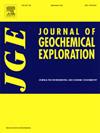Hydrochemical processes and water balance trends based on stable isotopes of typical alpine lakes in the Qinghai-Tibet Plateau
IF 3.4
2区 地球科学
Q1 GEOCHEMISTRY & GEOPHYSICS
引用次数: 0
Abstract
Due to the warming climate, the hydrological cycle of the Qinghai-Tibet Plateau (QTP) is accelerating, leading to continuous growth of alpine lakes. In case of overflow, this can pose significant risks to downstream water quality and resources. However, there is a lack of comprehensive investigations on the chemical composition and water balance of lakes in QTP. This study examines the evolutionary mechanisms of alpine lakes in the Yanhu Lake Basin (YHB) located in central QTP. It investigates stable isotopes (δ18O and δD), hydrochemistry, and utilizes the isotope balance model to determine the evaporation to inflow (E/I) ratio of lake water. The findings reveal that lake water exhibits a Cl![]() Na hydrochemical type with enrichment in total dissolved solids (TDS), boron (B), and lithium (Li) elements. On the δD- δ18O plot, lake water falls below the Local Meteoric Water Line (LMWL) towards rightward direction with a slope of 4.75 and an intercept of 11.83, indicating pronounced evaporation characteristics. The presence of more positive isotope signals and ratios among major ions suggests that evaporation processes primarily govern lake water's hydrochemistry. The modeled E/I ratio ranges from 0.19 to 0.65 across YHB, implying a positive lake water balance which contributes to consistent expansion in surface area. This highlights the need for local government to enhance monitoring efforts, closely observe fluctuations in Yanhu Lake's water level, expedite implementation of lake water diversion projects, and conduct comprehensive assessment on their potential impact on local ecological environment.
Na hydrochemical type with enrichment in total dissolved solids (TDS), boron (B), and lithium (Li) elements. On the δD- δ18O plot, lake water falls below the Local Meteoric Water Line (LMWL) towards rightward direction with a slope of 4.75 and an intercept of 11.83, indicating pronounced evaporation characteristics. The presence of more positive isotope signals and ratios among major ions suggests that evaporation processes primarily govern lake water's hydrochemistry. The modeled E/I ratio ranges from 0.19 to 0.65 across YHB, implying a positive lake water balance which contributes to consistent expansion in surface area. This highlights the need for local government to enhance monitoring efforts, closely observe fluctuations in Yanhu Lake's water level, expedite implementation of lake water diversion projects, and conduct comprehensive assessment on their potential impact on local ecological environment.
求助全文
约1分钟内获得全文
求助全文
来源期刊

Journal of Geochemical Exploration
地学-地球化学与地球物理
CiteScore
7.40
自引率
7.70%
发文量
148
审稿时长
8.1 months
期刊介绍:
Journal of Geochemical Exploration is mostly dedicated to publication of original studies in exploration and environmental geochemistry and related topics.
Contributions considered of prevalent interest for the journal include researches based on the application of innovative methods to:
define the genesis and the evolution of mineral deposits including transfer of elements in large-scale mineralized areas.
analyze complex systems at the boundaries between bio-geochemistry, metal transport and mineral accumulation.
evaluate effects of historical mining activities on the surface environment.
trace pollutant sources and define their fate and transport models in the near-surface and surface environments involving solid, fluid and aerial matrices.
assess and quantify natural and technogenic radioactivity in the environment.
determine geochemical anomalies and set baseline reference values using compositional data analysis, multivariate statistics and geo-spatial analysis.
assess the impacts of anthropogenic contamination on ecosystems and human health at local and regional scale to prioritize and classify risks through deterministic and stochastic approaches.
Papers dedicated to the presentation of newly developed methods in analytical geochemistry to be applied in the field or in laboratory are also within the topics of interest for the journal.
 求助内容:
求助内容: 应助结果提醒方式:
应助结果提醒方式:


